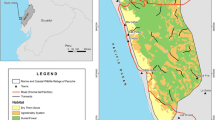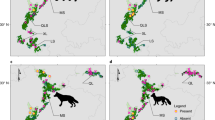Abstract
Insular carnivores represent some of the most critically threatened species, but also the least known. To evaluate the conservation status of these species, thorough abundance estimates are urgently required. To better understand the population biology and conservation status of the endemic and threatened pygmy raccoon (Procyon pygmaeus) and dwarf coati (Nasua nelsoni) on Cozumel Island, Mexico, we worked island-wide to identify the presence of these species, and for the pygmy raccoon we studied several populations in depth during 2001–2003. On Cozumel, trapping was conducted for >6,600 trap nights in 19 locations of varying habitat types. A total of 96 pygmy raccoons (47 males and 49 females) and a single adult, male dwarf coati (N. nelsoni) were captured. Estimated total annual pygmy raccoon population size ± SE was 80 ± 26.1, resulting in an average density of 22 ± 5.1 raccoons/km2 for the three small sites where the animals persist. Based in part on the findings of this study that indicate these species have a restricted range and small population numbers, the IUCN recently changed the listing of the pygmy raccoon to Critically Endangered from Endangered. In contrast, the status of the dwarf coati (Endangered) has not been changed, although the taxon is in eminent danger of extinction and in need of immediate conservation action.

Similar content being viewed by others
References
Alcover JA, McMinn M (1994) Predators of vertebrates on islands. Bioscience 44:12–18
Bautista SM (2006) Distribución, abundancia y dieta de perros y gatos ferales en la Isla Cozumel. M.Sc thesis, Instituto de Ecología, A.C
Carrillo E, Wong G, Rodriguez MA (2001) Feeding habits of the raccoon (Procyon lotor) (Carnivora: Procyonidae) in a coastal, tropical wet forest of Costa Rica. Rev Biol Trop 49:1193–1197
Copa-Álvaro ME (2007) Efectos de los huracanes Emily y Wilma en los mamíferos medianos de Cozumel. M.Sc thesis, Universidad Nacional Autónoma de México
Cuarón AD (2009) Cozumel. In: Gillespie R, Clague DA (eds) Encyclopedia of Islands. University of California Press, Berkeley, pp 203–206
Cuarón AD, Martinez-Morales MA, McFadden KW, Valenzuela D, Gompper ME (2004) The status of dwarf carnivores on Cozumel Island, Mexico. Biodivers Conserv 13:317–331
Cuarón AD, de Grammont PC, Vázquez-Domínguez E, Valenzuela-Galván D, García-Vasco D, Reid F, Helgen K (2008) Procyon pygmaeus. In: IUCN 2008 IUCN red list of threatened species. www.iucnredlist.org. Downloaded on 19 November 2008
Decker DM (1991) Systematics of the coatis, genus Nasua (Mammalia: Procyonidae). Proc Biol Soc Wash 104:370–386
García-Vasco D (2005) Distribución, abundancia y aspectos poblacionales del mapache enano (Procyon pygmaeus), un carnívoro insular endémico. Licenciatura (Advanced BSc) Thesis, Universidad Veracruzana
Gittleman JL, Funk S, MacDonald D, Wayne R (2001) Why ‘carnivore conservation’? In: Gittleman JL et al (eds) Carnivore conservation. Cambridge University Press, Cambridge, pp 1–7
Glatston AR (1994) Threats to procyonids and ailurids. In: Glatston AR (ed) The red panda, olingos, coatis, and raccoons and their relatives. IUCN, Gland, pp 1–42
Goldman EA (1950) Raccoons of North and Middle America. North Am Fauna 60:1–153
Gompper ME (1997) Population ecology of the white-nosed coati (Nasua narica) on Barro Colorado Island, Panama. J Zool 24:441–455
Grau GA, Sanderson GC, Rogers JP (1970) Age determination of raccoons. J Wild Manag 34:364–372
Hamblin NL (1984) Animal use by the Cozumel Maya. The University of Arizona Press, Tuscon
IUCN (World Conservation Union) (2008) IUCN red list categories and criteria: version 3.1. Species survival commission. IUCN, Gland
Jones JK, Lawlor TE (1965) Mammals from Isla Cozumel, Mexico, with description of a new species of harvest mouse. Univ Kansas Publ Mus Nat Hist 16:409–419
Karanth KU, Nichols JD (1998) Estimation of tiger densities in India using photographic captures and recaptures. Ecology 79:2852–2862
Kendall WL, Nichols JD (1995) On the use of secondary capture-recapture samples to estimate temporary emigration and breeding proportions. J Appl Stat 22:751–762
Kendall WL, Nichols JD, Hines JE (1997) Estimating temporary emigration using capture-recapture data with Pollock’s robust design. Ecology 78:563–578
Kenward RE (1985) Ranging behaviour and population dynamics in grey squirrels. In: Sibly RM, Smith RH (eds) Behavioural ecology—ecological consequences of adaptive behaviour. Blackwell, Oxford, pp 319–330
Martínez-Morales MA (1996) The Cozumel curassow: abundance, habitat preference and conservation. MPhil thesis, University of Cambridge, UK
Martínez-Morales MA, Cuarón AD (1999) Boa constrictor, an introduced predator threatening the endemic fauna on Cozumel Island, Mexico. Biodivers Conserv 8:957–963
McFadden KW (2004) The ecology, evolution, and natural history of the endangered carnivores of Cozumel Island, Mexico. Dissertation, Columbia University
McFadden KW, Wade SW, Dubovi EJ, Gompper ME (2005) A serological and fecal parasitologic survey of the critically endangered pygmy raccoon (Procyon pygmaeus). J Wildl Dis 41:615–617
McFadden KW, Sambrotto RN, Medellín RA, Gompper ME (2006) Feeding habits of endangered pygmy raccoons (Procyon pygmaeus) based on stable isotope and fecal analyses. J Mammal 87:501–509
McFadden KW, Gompper ME, Valenzuela DG, Morales JC (2008) Evolutionary history of the critically endangered Cozumel dwarf carnivores inferred from mitochondrial DNA analyses. J Zool 276:176–186
Mena H (2007) Presencia de Leptospira spp. y moquillo canino en poblaciones de perros y carnívoros silvestres en la Isla Cozumel. M.Sc thesis, Universidad Nacional Autónoma de México
Merriam CH (1901) Six new mammals from Cozumel Island, Yucatan. Proc Biol Soc Wash 14:99–104
Navarro D, Suárez M (1989) A survey of the pygmy raccoon (Procyon pygmaeus) of Cozumel, Mexico. Mammalia 53:458–461
Otis DL, Burnham KP, White GC, Anderson DR (1978) Statistical inference for capture data on closed animal populations. Wildl Monogr 62:1–24
Perdomo H (2006) Caminos como barreras para el movimiento de aves y efectos del huracán Wilma, en una comunidad de aves de sotobosque de la selva mediana subcaducifolia de la Isla Cozumel. M.Sc thesis, Universidad Nacional Autónoma de México
Pollock K, Nichols JD, Brownie C (1990) Statistical inference for capture-recapture experiments. Wildl Monogr 107:1–97
Roemer GW, Gompper ME, Van Valkenburgh B (2009) The ecological role of the mammalian mesocarnivore. Bioscience 59:165–173
Romero-Nájera I, Cuarón AD, González-Baca C (2007) Distribution, abundance, and habitat use of introduced Boa constrictor threatening the native biota of Cozumel Island, Mexico. Biodivers Conserv 16:1183–1195
Samudio R, Kays R, Cuarón AD, Pino JL, Helgen K (2008) Nasua narica. In: IUCN, 2008 IUCN red list of threatened species. www.iucnredlist.org. Downloaded on 19 November 2008
Sanderson GC, Nalbandov AV (1973) The reproductive cycle of the raccoon in Illinois. Illinois Nat Hist Surv Bull 31:29–85
Secretaria de Desarrollo Urbano y Medio Ambiente (2008) Programa de Ordenamiento Ecológico Local del Municipio de Cozumel. http://seduma.qroo.gob.mx/bitacora/index.php?option=com_docman&task=catview&gid=108&Itemid=33. Downloaded on 19 November 2008
Téllez VO, Cabrera EF (1987) Listados floristicos de Mexico-VI. Instituto de Biología, Universidad Nacional Autonóma de México, México City
Thomas O (1901) New insular forms of Nasua and Dasyprocta. Ann Mag Nat Hist 7:271–273
Valenzuela D (1998) Natural history of the white-nosed coati, Nasua narica, in a tropical dry forest of western Mexico. Rev Mex Mastozoo 3:26–44
White GC, Burnham KP (1999) Program MARK: survival estimation from populations of marked animals. Bird Study 46:120–138
Williamson M (1981) Island populations. Oxford University Press, Oxford
Acknowledgments
This research was approved by Columbia University’s Institutional Animal Care and Use Committee (IACUC), and supported by funds from the Explorer’s Club, Sigma Xi, Sigma Delta Epsilon Women in Science, the American Museum of Natural History, Columbia University, the University of Missouri, the National Science Foundation (#0118867), the Consejo Nacional de Ciencia y Tecnología grant (#33635-V), and the Fondo Sectorial de Investigación Ambiental (SEMARNAT-2002-C01-0571). Field support and local assistance was provided by J. Benavides, R. Chacón, I. Fortes, C. González-Baca, H. González, A. Laborde, M.A. Martínez-Morales, C. Naredo, G. Navarro, PROFEPA, I. Romero-Nájera, R. Sheese, and E. Vivas (CAPA).
Author information
Authors and Affiliations
Corresponding author
Appendix 1
Appendix 1
See Table 3.
Rights and permissions
About this article
Cite this article
McFadden, K.W., García-Vasco, D., Cuarón, A.D. et al. Vulnerable island carnivores: the endangered endemic dwarf procyonids from Cozumel Island. Biodivers Conserv 19, 491–502 (2010). https://doi.org/10.1007/s10531-009-9701-8
Received:
Accepted:
Published:
Issue Date:
DOI: https://doi.org/10.1007/s10531-009-9701-8




